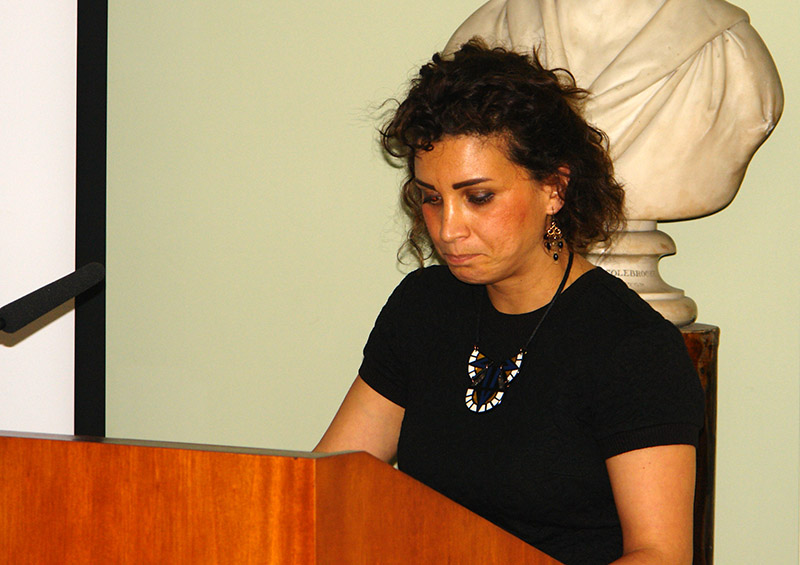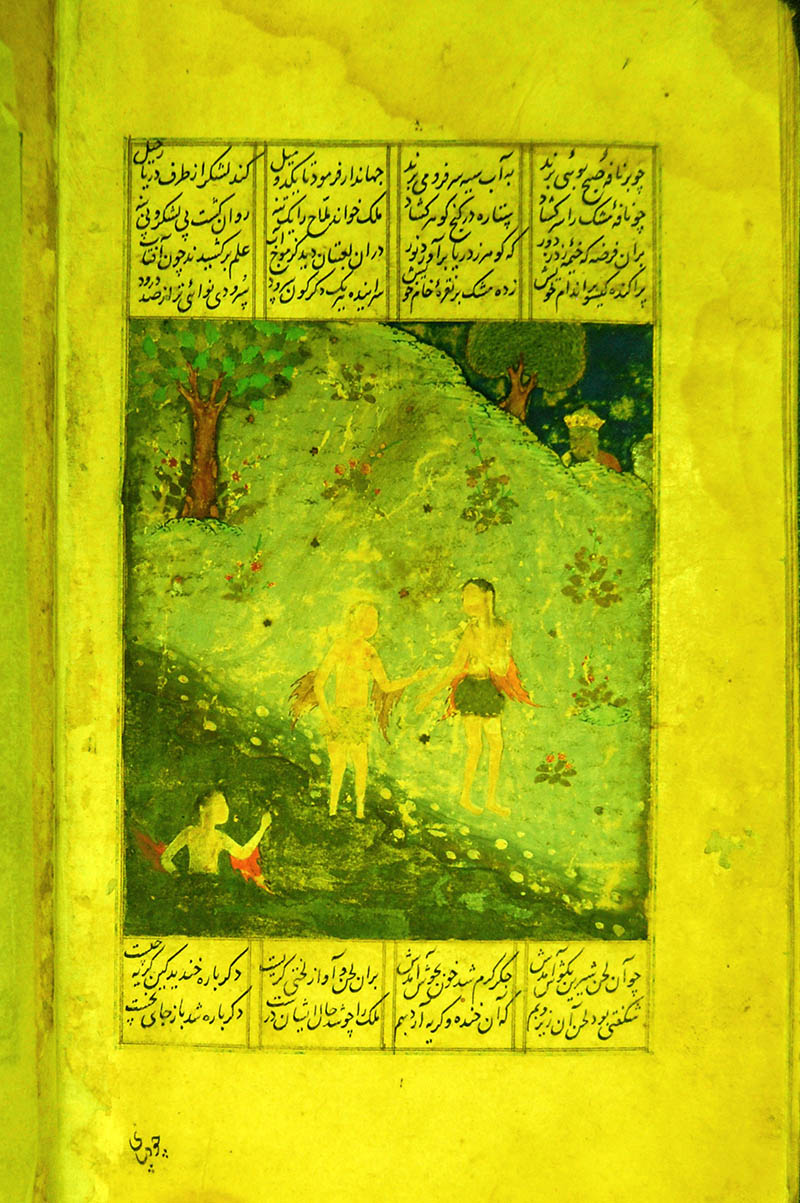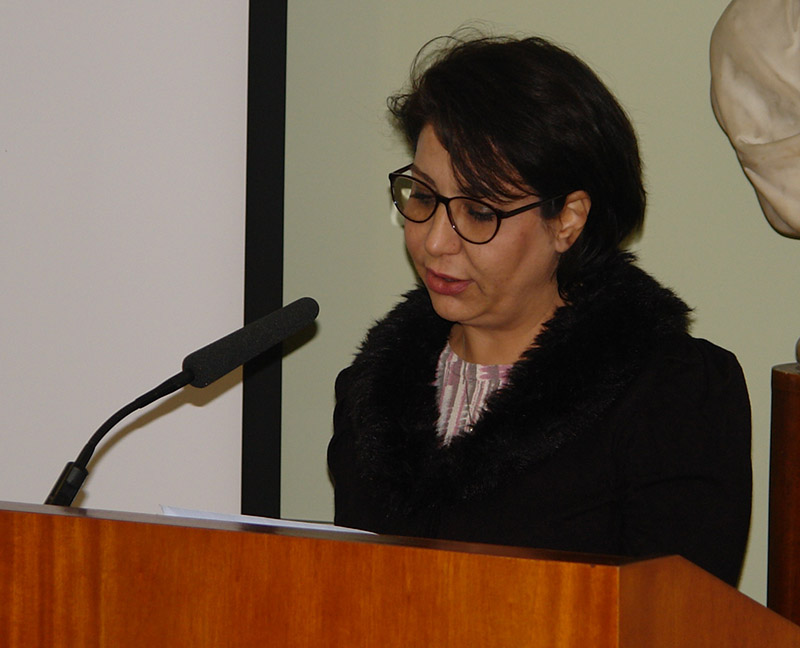Nizami the Poet takes Centre-Stage
On Tuesday 17th November we welcomed Azadeh Fatehrad to lecture on the poet, Nizami Ganjavi. She started by giving an introduction to the poet’s life and work and, in particular, his five epic poems, the Quinary (Panj Ganj in Persian or Khamsa in Arabic). This work contains the stories Makhzan al-Asrar (The Treasury of Mysteries), the epic romances of Khosrow and Shirin and Layla and Majnun, the Eskandar Nameh (Story of Alexander), and the Haft Paykar (The Seven Beauties).

Azadeh, in particular, considered the Eskander Nameh, studying a picture from the Panj Ganj or Khamsah, presented by Lieutenant Colonel C.J. Doyle to the RAS (Persian Manuscript 246)

In this miniature, Alexander is seen observing bathing women from his hiding place behind a wall. Azadeh pondered on the pleasure that Alexander would have known in being able to see this sight, but then also considered the difficulties and shame that might occur when someone knows they are being watched or are caught as the watcher. As she was speaking I also wondered about whether Nizami was putting himself in the place of Alexander – a good writer needs to be able to observe from the outside and describe the scene in a way that will give pleasure to others.
Following Nizami’s talk, Ned Khalighi, an Iranian poet, read us part of Nizami’s epic. It was interesting to be able to hear the poetic structure of rhyming couplets even though I could not understand the language.

The RAS Collections hold several versions of Nizami’s poetry. So, in keeping with the lecture, and also because it is Explore Your Archives week and we are running a creative writing workshop this Friday, November 20th, we decided to change the material in the cabinet in the Reading Room. So Lady Anna Maria Jones was safely packed away and Nizami’s poetry is now on display. There are three manuscripts out to look at:
- Panj Ganj or Khamsah, Nasta’liq. Fol. 338. 23 lines to the page in four columns. Size, 8.5 inches by 5.5. Presented by Lieutenant Colonel C.J. Doyle A manuscript of high quality, with fine illumination and 21 miniatures, attributed by Robinson to the Turkman school ca. 1450 CE. This is RAS Persian 246, (mentioned earlier)
- Makhzan al-Asrar, and Laila o Majnun, Nastaʿlīq. 19 lines to page. Size, 9.5 inches by 6.25. Presented by R.S. Greenshields. The headings are in gold outlined in black on panels decorated with split palmette scrolls in gold and black spotted with blue. Richly illuminated initial opening of text. There are six coloured miniatures, in the Shiraz style of the later fifteenth century. Completed ca. 1477 CE (AH 882). The Makhzan al-Asrar contains twenty discourses, each of them portraying an exemplary story on religious and ethical topics, and each chapter concludes with an apostrophe to the poet himself. Laila o Majnun is based on the popular Arab legend of ill-starred lovers. It is reputed that Nizami initially doubted that what could be construed as a simple story would be a suitable subject for royal court poetry and his cultured audience. It was his son who persuaded him to undertake the project, saying: “wherever tales of love are read, this will add spice to them”. RAS Persian 248a

- Eskandar Nameh, Nastaʿlīq. 149 folios. 18 lines to the page in four columns. Size, 10.25 inches by 6.5. A manuscript of high quality, probably produced at the Safavid court. The ruled margins are in gold. The headings are in gold outlined with black against scrolling vegetation. There is a fine panel of original illumination at the opening of the second part (f97b). This manuscript dates from Safar AH 932 (late 1525 CE). The Romance of Alexander the Great is based on the legends of Alexander’s life, narrated in three stages: as the conqueror of the world; as a seeker after knowledge, gaining enough wisdom to acknowledge his own ignorance; and finally as a prophet, traveling once again across the world, from west to east, and south to north to proclaim his monotheistic creed to the world at large. RAS Persian 249a
Please do take the opportunity of coming into the Reading Room to see these beautiful manuscripts. Please also come to our December lectures. The next Fresh Perspectives lecture will be earlier in the month than usual on Tuesday 8th December (and different to advertised in the programme) when John Earle from the University of Plymouth will lecture on “British Vice-Consul and Local Hero: Nicholas Loney and a Sweeter Life on a 19th Century Philippine Island”. Our next lecture in the main series will be on Thursday 10th December when Kaveh Bakhtiar will lecture on “The British Mosque: fragments of an alternative architecture”.
